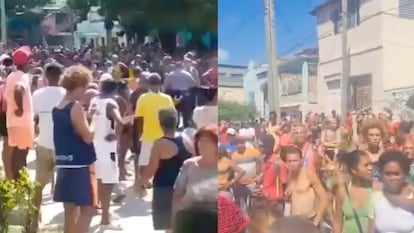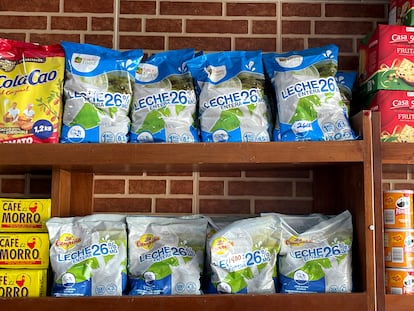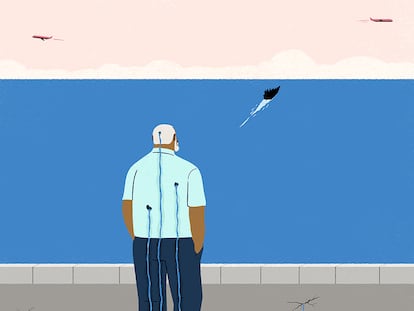Cubans return to the streets in protest against electricity and food shortages
Sunday’s mobilization in Santiago de Cuba is the largest since the July 2021 protests that were quelled with hundreds of arrests

Hundreds of Cubans took to the streets Sunday in the province of Santiago de Cuba, in the east of the island, to protest against the lack of electricity and food shortages in a mobilization that was repeated in other provinces around the country. Although there have been other demonstrations of discontent in recent times, it was the largest protest that has taken place since those of July 11 and 12, 2021, when thousands of people came out to demand changes to alleviate the crisis in the country, which three years later has only deepened. Those protests were quelled with the arrests of hundreds of people.
On Sunday, protestors in Santiago de Cuba denounced that the government had cut mobile data services — as they did in the protests of July 2021 — to prevent them from reporting on the unrest and to stop it from spreading to other parts of the country. However, several videos have been shared on social networks where hundreds of citizens can be seen shouting in chorus the words “current” — in reference to the lack of electricity — “food,” and the phrase “Patria y Vida (Homeland and Life),” which became an anthem during the previous protests. Hours later, early on Sunday night, there were reports of protests in other provinces such as Havana, Bayamo, and Artemisa, where citizens took to the streets shouting “freedom.”
Cuban President Miguel Díaz-Canel issued a thread of messages on his X account in which he acknowledged citizen discontent “with the situation of the electricity service and food distribution,” while claiming that “the enemies of the Revolution” were trying to take advantage of the situation “for purposes of destabilization.”
“In these last hours we have seen how terrorists based in the U.S., whom we have denounced on repeated occasions, encourage actions against the internal order of the country,” Díaz-Canel wrote. “The disposition of the authorities of the party, the state and the government is to attend to the demands of our people, to listen, to dialogue, to explain the numerous steps that are being taken to improve the situation, always in an atmosphere of tranquility.” The president concluded: “In the midst of an embargo that is intended to suffocate us, we will continue working in peace to get out of this situation.”
The U.S. embassy in Cuba issued a brief message on its Facebook account citing “reports of peaceful protests in Santiago, Bayamo, Granma, and elsewhere in Cuba, with citizens protesting the lack of food and electricity.” The diplomatic legation urged the Díaz-Canel government “to respect the human rights of the protestors and address the legitimate needs of the Cuban people.”
Surgen imágenes de protestas pacíficas en #SantiagoDeCuba 🇨🇺
— Erika Guevara Rosas (@ErikaGuevaraR) March 17, 2024
Gobierno de @DiazCanelB tiene la obligación de proteger el derecho a protestar. La represión violenta a la que siempre recurre su gobierno no debe ser tolerada por la comunidad internacional
pic.twitter.com/aQrDfAJZ7N
Sparks fly in Santiago
Evelyn Suñe, who lives in the Micro 3 neighborhood of Santiago de Cuba, explains that residents have been without electricity for up to 18 hours a day in recent days. “They put the light on for three hours and then switch it off again. The cause of these protests is social discontent over the lack of supplies. That is what is being asked for; that is why people are shouting for electricity and food.” According to Suñe, in his neighborhood, several people also demonstrated on March 13 for the same reason.
A video sent to this newspaper and accompanying this article shows a leader of the Communist Party of Santiago de Cuba, first secretary Beatriz Jhonson Urrutia, on a rooftop trying to calm the demonstrators. She is heard talking about the distribution of milk and supplies from the subsidized basic food basket program, while the protestors become restless and shout her down.
It remains unclear whether the government stopped the protests or if there were arrests, as in the 2021 protests when over 1,400 people were detained and many subsequently sentenced with up to 20 years in prison.
Another Santiago de Cuba resident, who asked to remain anonymous, said that although her neighborhood was “quiet,” protests had been taking place nearby and that demonstrators had gone as far as the headquarters of the Communist Party of Cuba to complain. “There’s really no one who can take it anymore. Here nothing arrives at the butcher’s, there is no food, no milk for the children. We are in the dark all day, they turn off the electricity all night and turn it on at 6 a.m. If I were in good health, I would have joined the protest, because it is impossible for the people to live like this.”
Over the last few days small demonstrations have been reported in other areas of the country, such as those that took place in the municipality of San Antonio de los Baños, in Artemisa, or in Cacocum, in Holguín, where several people took to the streets banging pots in protest against the power cuts.
The state-run electricity company issues constant warnings of power cuts lasting several hours throughout Cuba, adding to the discontent of a population already burdened by the economic shortages the country is experiencing. At the end of last year, Minister of Energy and Mines Vicente de la O Levy announced on national television that there would be blackouts amid the withdrawal of fuel aid that partners such as Mexico or Venezuela were providing to Cuba. And although the minister promised improvements, the truth is that a brighter outlook for Cubans remains out of sight.
Sign up for our weekly newsletter to get more English-language news coverage from EL PAÍS USA Edition









































